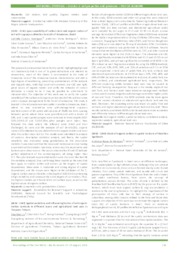Stock of organic carbon in spodic horizons of Brazilian Spodosols.
Stock of organic carbon in spodic horizons of Brazilian Spodosols.
Autoria: MENEZES, A. R. de; FONTANA, A.; ANJOS, L. H. C. dos; PEREIRA, M. G.
Resumo: Soils classified as Spodosols in Brazil occur at different landscapes, from coastal plains to high altitude areas. Although they are present in different environments, these soils are formed mainly under humid climates, from sandy parent materials, and usually with shrub and grasses vegetation. They differ from Spodosols from the cold climates and under coniferous forests, from where the concept of podzolization process derived. This order of soils is defined by the Brazilian Soil Classification System (SiBCS) by the presence if a spodic horizon, which must have organic carbon (C org) accumulation in relation to the overlying horizons. To highlight the importance of the preservation of these soils due to their storage of carbon in subsurface, among other reasons related to the flora and fauna they support, the objective of this work was to estimate the organic carbon stock (Ec) of spodic horizons in Brazil. From an extensive bibliographical search, 38 profiles identified as Spodosols according to the SiBCS were selected, and the C org in g kg-1, bulk density (Ds) in Mg m-3 and thickness (E) in cm of the spodic sub-horizons data was organized in a spread sheet for evaluation of descriptive statistics
Ano de publicação: 2019
Tipo de publicação: Resumo em anais e proceedings
Unidade: Embrapa Solos
Palavras-chave: Carbono, Espodossolo, Estoque de carbono no solo, SiBCS
Observações
1 - Por padrão são exibidas publicações dos últimos 20 anos. Para encontrar publicações mais antigas, configure o filtro ano de publicação, colocando o ano a partir do qual você deseja encontrar publicações. O filtro está na coluna da esquerda na busca acima.
2 - Para ler algumas publicações da Embrapa (apenas as que estão em formato ePub), é necessário ter, no celular ou computador, um desses softwares gratuitos. Sistemas Android: Google Play Livros; IOS: iBooks; Windows e Linux: software Calibre.
Acesse outras publicações
Acesse a Base de Dados da Pesquisa Agropecuária (BDPA) para consultar o acervo completo das bibliotecas da Embrapa.

